Translate this page into:
Gold nanoparticles: Synthesis properties and applications
⁎Corresponding author. nmalabdallah@iau.edu.sa (Nadiyah M. Alabdallah)
-
Received: ,
Accepted: ,
This article was originally published by Elsevier and was migrated to Scientific Scholar after the change of Publisher.
Peer review under responsibility of King Saud University.
Abstract
In recent years, nanotechnology has been the topic of extensive research and a great deal of interest among researchers. The manufacturing and utilization of nanoparticles (NPs) has expanded dramatically as a result of the rapid development of nanotechnology. Gold nanoparticles (AuNPs) are one of the most important nanoparticles, and they have been widely used for medical and non-medical applications as ideal material because of their unique distinct features: inert, biocompatible, and especially due to low toxicity. It is can be manufacture on a massive scale by reducing the oxidation of gold Au+1(aureus) or Au+3(auric) to Au0 by subjoin a reducing agent through various physical, chemical, and biological methods under different circumstance. Researchers have been motivated by the harmful effects of current synthesis methods to focus on the production of environmentally sustainable and green synthesis using non-toxic chemicals from natural sources, such as plant extract, bacteria, and fungi. The preparation of Gold nanoparticles can be done inwardly or outside by microbes, but outside the cell handling is facile in terms of insulation. Modified nanocellulose is a preferred technique for gold nanoparticle extraction. AuNPs have shown outstanding applications for diagnostic and therapeutic uses, including biosensor applications, tumor-targeting capability (Anticancer Activity) for cancer therapy, and precise drug delivery of nano-vehicles to diseased tissues.
Keywords
Nanoparticles
Gold nanoparticles
AuNPs
Anticancer activities
1 Introduction
A wide variety of medicinal products which originate from natural compounds and which are widely used to target and treat various appear diseases. The extraction of these complicated chemical molecules from plants, animals, microorganisms and minerals are common natural sources via several extraction processes, these compounds work as an initiator of future sinker molecules. Gold is inert and universally recognized as biocompatible. Until the recent past, it was only known as the metal. With the arrival of nanotechnology and the discovery of nanoparticles and the exploration of the physico-chemical properties of gold make it a supreme material for progress fields (Kalimuthu et al., 2020; Meena et al., 2020). A nanoparticle is defined as a tiny particle with a size ranging between 1 and 100 nm. The description of AuNPs was documented since 1996 (Fig. 1).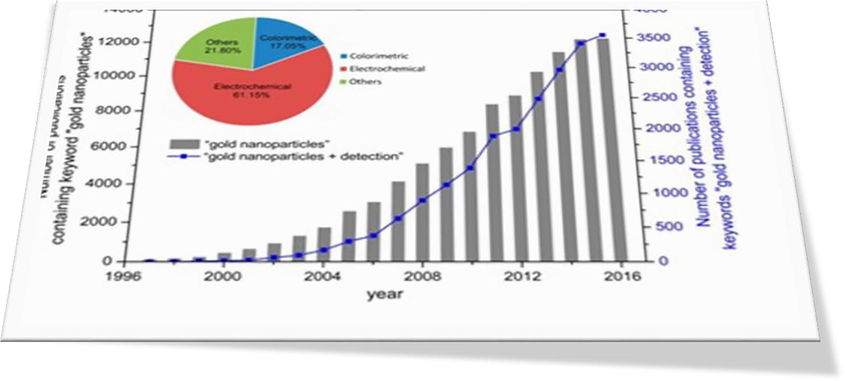
Documentation of AuNPs in the publications since 1996–2016.
Tiny structures of at least one scale less than 100 nm, are firstly noticed by Michael Faraday in 1857, while he produced gold nanoparticles and observed that nanostructured gold emitted a red color. Commenting on fact (the more dilute preparations = solution become clear), goes on to say: “holding no disbanded, except uniquely diffused gold. The particles are simply speckled by collecting the sun's rays (or the candle) into the cone by the lens, and dropping the part of the cone near the middle into the liquid; the cone becomes visible, and although the lighted particles cannot be recognized by their thoroughness, the radiance they shine back is golden, and is detect to be plentiful in ratio to the amount of solid gold. This is the primary clearly expressed explanation of which at present called the Tyndall impact. This distinct characteristic of gold nanoparticles may be due to its minute size. The AuNPs are very small relative to the wavelengths of light, absorbing light in the blue-green part of the spectrum (∼450 nm), and reflecting red light (∼700 nm) provides a rich red color (ruby gold). After Michael Faraday's discovery, it was the birth of modern nanotechnology; and many scientists took this approach because of its fertile field of research (Ansari, 2019; Edwards and Thomas, 2007) (see Figs. 2 and 3).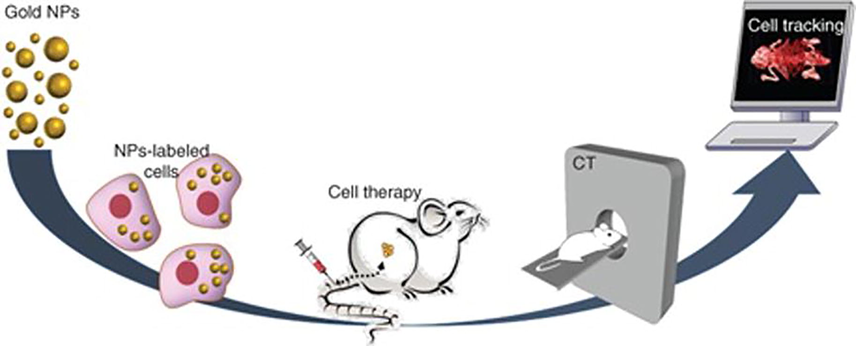
In vivo tracking of therapeutic cells.
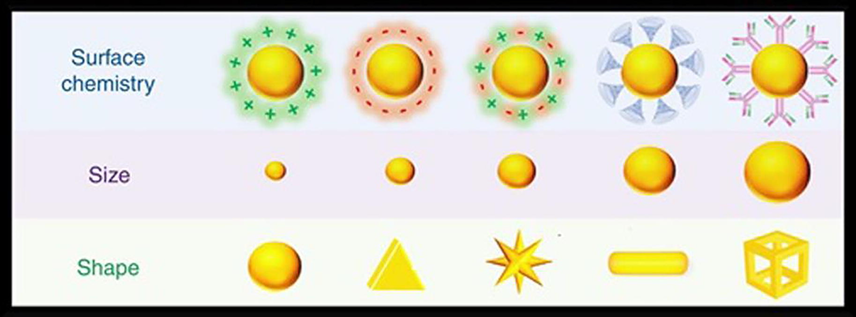
Modifications of AuNPs in a wide verity.
The “nanoparticles” concept refers to a very unique intermediate atom and bulk materials, allowing materials to display specific photonic, electronic, catalytic, and therapeutic characteristics. Even though the term could be operated to any substance along a diameter of smaller than 1 μm roughly 1–100 nm, it is most widely used to describe the particle in biology laboratories (Soloviev, 2012; Di Pietro et al., 2016). Configurations of nanoparticles include those containing core organic molecules (such as liposomes, DNA, fatty acids, viruses, and micelles), inorganic molecules (such as iron oxide, gold, and carbon nanotubes), or hybrids containing two or more of these elements (Herizchi et al., 2016). In vitro nanoparticles are used for labeling biomolecules or cells, transfection, and routine imaging reagents. In living animal models, nanoparticles are an extremely efficient target for medical imaging (magnetic nanoparticles and nanobubbles), medication distribution and cell tracking. Studies have shown that AuNPs can be used to tag range types of cells, enclosed stem cells and immune cells, effectively in the absence of harming their therapeutic effectiveness (Meir and Popovtzer, 2018).
Nano-carriers have the ability to absorb large quantities of drugs that would have inadequate pharmacokinetics or too high a toxicity on their own. Because of their small size, embedded drugs have the ability to spread extensively in tissues (Soloviev, 2012). Nanomaterials exhibit different physicochemical estate, such as nano-range dimension, size dispantion, area, and volume ratio, various surface structures, form, chemical composition, and agglomeration, which are not seeming in bulkiness materials (Dasgupta, 2018). Over the last decade, nanotechnology techniques have been used in a variety of industrial fields, such as cosmetics, medicine, food, building materials, etc.
Some useful applications are nano-capsules that are inserted into food products to increase the absorption rate of supply nutrients. Organic and polymeric nanoparticles are used to transmit vitamins to food and drink without affecting taste and appearance (Ingale and Chaudhari, 2018).
One of the most important types of metal nanoparticles is those composed of noble metals such as gold (Au). AuNPs have received a great deal of attention because of their ability to interact with light via surface plasma resonance (SPR). Recent advances in the field of nanoscience has shown that gold nanoparticles (Au NPs) have the capability to reinforce as building blocks for plasmonic devices and other optical devices in the future. Gold nanoparticles (NPs) have been used in a variety of applications such as chemistry, material sciences, physical, medicine, and life sciences have to get bigger exponentially, due to their multifunctional characteristics in therapeutics, detection, imaging, and surface alteration. Metallic nanoparticles such as gold have been widely used as nanomaterials for theranostic applications in cancer therapy. In the biomedical field, it is used for highly sensitive biomolecular screening, selective extermination of cancer cells by photo thermal therapy, specific cells, labeling of proteins and cellular therapeutic delivering (Kalimuthu et al., 2020; Soloviev, 2012; Lee et al., 2019).
The transport mechanism of these AuNPs drug molecules is primarily transported by passive diffusion (nonspecific passive transport) or active transport systems depending on energy. These are administered orally then absorbed through the gastrointestinal tract and typically distributed across the entire body via the venous system. Besides, these can be transported directly to intravenous target organs, either rapidly removed from the body by protective mechanisms such as clearance by the reticuloendothelial system (RES) once in blood circulation or circulated for a long time depending on the size, shape, and surface characteristics of nanoparticles (Ansari,). Also, it allows facile disposition into different size, shape, and fixation of various functional groups, chemically biocompatible, and have basic tunable optical properties (Meena et al., 2020). It can be synthesized from plants, fungi, and Bactria by different physical, chemical, and biological methods which is an active and more important academic field (Kalimuthu et al., 2020). The challenge of finding appropriate particle size, shape and surface chemistry for the potential use requires additional research on nanoparticle interactions with cells or tissues (Hoshyar et al., 2016).
2 Synthesis of gold nanoparticles
Nanoparticles have been synthesized through a variety of physiochemical processes, all of which have placed significant environmental demand on the environment. Gold nanoparticles are the most important of the metal nanoparticles mentioned above because of their long record of therapeutic applications. The most widely reported form in the literature is gold nanoparticles. Since 1996, approximately 87,000 papers have been published. Copper, silver, iron, and titanium nanoparticles are all well-documented and should be studied separately (Daruich De Souza et al., 2019). For the synthesis of gold nanoparticles, a number of different biological, physical and chemical synthesis techniques have been developed.
3 Biological
The biological synthesis of nanoparticles is a safe, dynamic, and energy efficient method of producing nanoparticles. This approach comprises a range of biological resources ranging from prokaryotes to eukaryotes to synthesize NPs in vivo. Metabolites (proteins, fatty acids, sugars, enzymes, and phenolic compounds) found in these sources play a significant role in both the bioreduction of metallic ions to NPs and their stability. AuNPs generated biologically are more stable than those generated using other methods. AuNPs can efficiently manufacture from chemical routes, but the main risk is the generation of by-products (secondary product) that are hazardous to human health and the environment. New routes for the production of safe nanoproducts are therefore being intensively explored by many biological systems, such as plants, bacteria, yeasts, and fungi, for the manufacture of AuNPs (Teimouri et al., 2018).
4 Green synthesis of plant extract -AuNPs
Nature is rich with a wellspring of plants which has the advantage of a low cost, high reproducibility, eco-friendly and precise purification process compared to other environmentally friendly biological methods. The green pathways with the use of plant extracts as reducing agents and stabilizers for the preparation of gold nanoparticles has increased interest in not long past due to their several (Qiao and Qi, 2021; Fu et al., 2017).
5 The general approach to plant preparation-AuNPs
It's a direct method involves the selection of specific sections depending on the type of plants. For example, collect the root part of Euphorbia fischeriana plant which in general used as antioxidant, the pulp part of Punicagranatum as antimicrobial, the leaf from A. noeanum as antibacterial, and the juice of Papaya as Sensing L-Lys (Qiao and Qi, 2021; Khatua et al., 2020; Shahriari et al., 2019; Yu et al., 2019). For example, after chemical therapy, cancer cells become insensible as effect of repeated drug administration, nanoparticles are capable to raise the accumulation of intracellular drugs due to their power to target and distribute more specific drugs (Beik et al., 2019). agents and stabilizers. Polyphenols, flavonoids, sugar reduction, polysaccharides, alkaloids, amino acids, vitamins, ketones, phenols, and proteins are examples of plant extract biomolecules (Siddiqi and Husen, 2017). A plant containing at least one of the above-mentioned chemicals that reduces the metal ion to elemental metal must always be chosen for biosynthesis. First, reduce Au3+to Au0, then meditate and stabilized AuNPs by covering the outer surface of gold in order to prevent aggregation (Qiao and Qi, 2021). Fig. 4 represents the diagrammatic representation of plants-based synthesis of AuNPs.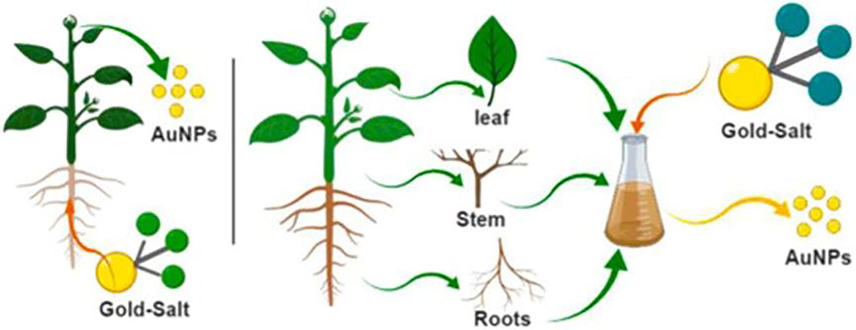
Schematic representation various parts of plant-based synthesis of AuNPs.
6 Green synthesis of AuNPs by cultivating plant cells
This is one of the methods for developing plant cells indefinitely. Hypocotyl regions from one-week-old seedlings germinated on water agar medium and inoculated on MS medium38, pH 5.7, supplemented with 30% sucrose, 0.8% agar, 0.2 mg/L IAA, and 0.2 mg/L BA. After couple of weeks, the callus mass was transferred to the same composition liquid medium. Callus clumps in conical flasks containing medium in an orbital shaker with 100 rpm at 27 °C for 48 h for cell suspension. A microscopic examination confirms the culture's single-cell existence (Bhaskaran et al., 2019). For AuNP Synthesis, cell culture was supplemented with KAuCl4 at a rate of 10–200 ppm and incubated on a shaker for 24 h in the dark. Pipetting the culture (1 ml) into the Eppendorf tubes, centrifugation for 2 min (14,000 rpm), and removal of the medium Several times, nanopore water was used to fully extract traces of medium and unreacted gold. The cells were resuspended in 100L of water before being lysed with a sonicator for 2 min. The formation of gold nanoparticles was discovered by studying the reaction of the color medium, which shifted from yellow to red. Following that, the resulting colloidal solution of gold nanoparticles was subjected to various characterization processes (Qiao and Qi, 2021; Bhaskaran et al., 2019).
7 Conditions of reaction
The morphology (shape and size) of gold nanoparticles is determined by the reaction conditions: pH, temperature, incubation time, plant extract concentration, and metal salt concentration. For example, the shape of gold nanoparticles changes as the pH of the medium changes; pH 2 = larger, rod-shaped / pH 3–4 = smaller, rod-shaped / pH 8 = spherical, oval, polyhedral / pH 9 = spherical / pH 10 = rod-shaped / pH 11 = nano-wires. The final size is also affected by pH, with higher pH (at pH 3) defining a smaller size of nanoparticles. Gold nanoparticles may have a variety of shapes depending on the temperature (25 °C-90 °C): triangular, pentagonal, hexagonal, and spherical. Rising temperature and salt concentration speed up the development of nanoparticles, with a maximum temperature of 50 °C and a concentration of 0.7 mM. The color change is caused primarily by a shape difference represented by the absorbance peak in the visible spectral area at 533 nm and 529 nm (Fig. 5) (Bhaskaran et al., 2019).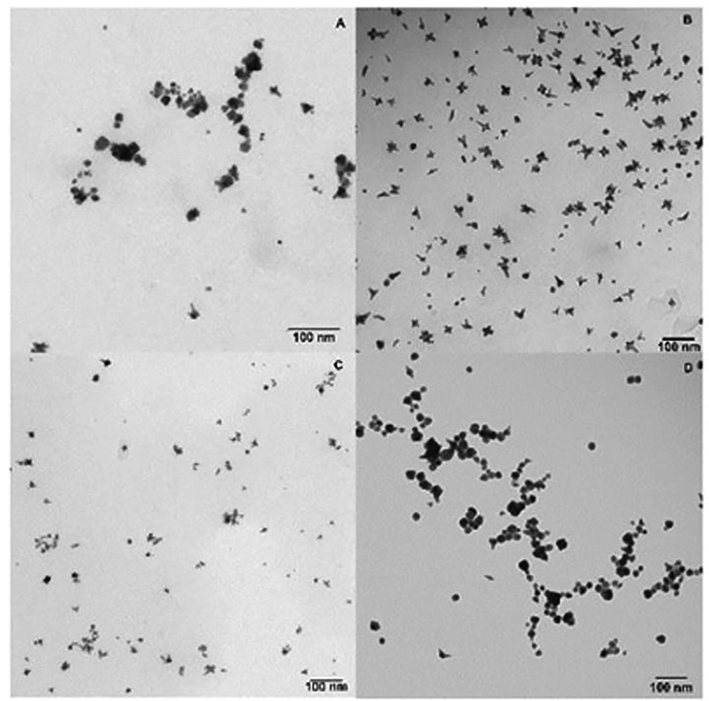
Four images captured through TEM of AuNPs through various morphologies with different pH values.
8 Green synthesis of Bacteria-AuNPs
Beveridge and Murray conducted their first research on the biosynthesis of gold nanoparticles (GNPs) using the bacteria Bacillus subtilis in 1980. Since then, a variety of microorganisms have been used to synthesize a variety of metals, nonmetals, metal oxides, and bimetallic nanoparticles, with more applications being considered. The use of marine bacteria to synthesize gold and silver nanoparticles has been active in recent years, as has the novel bacterial strain Marinobacteralgicola, which was isolated from marine waters in the Indian Sector's Southern Ocean. Furthermore, several bacteria, including strains of Bacillus, Cupriavidus, and Shewanella, were discovered to be capable of reducing Au(iii) to Au NPs (Gupta and Padmanabhan, 2021; Liu et al., 2018).
9 General approach of marine bacterium GNPs synthesis
A method that involves isolating the bacterium from water samples and growing it in broth for 24 h. Centrifugation is a method of harvesting biomass. Cell biomass is used to determine whether the enzyme responsible for GNP preparation is intracellular or extracellular. The cell biomass was washed twice in a phosphate buffer (pH 7, 0.05 M), then dissolved in 50 ml of distilled water and ultrasonicated (5 min, 30-second pulse) to break down the cell wall and release the enzyme into the aqueous system. The pellet is discarded by centrifugal solution and cell lysate supernatant (CLS). In a flask, (HAuCl4–1 mM) was mixed with (25 ml of supernatant) and stirred at 30 °C at 150 rpm for 72 h to produce AuNPs. Following an ultrasound, there was a notable shift of color from cell biomass. This shows that the enzyme is involved in intracellular processes in nature (Gupta and Padmanabhan, 2021).
10 The reaction condition
The experiment was conducted using Ultrapure Millipore water (18.2 M). Inoculating newly grown bacteria into a liquid medium containing LB (Luria – Bertani) broth facilitates bacterial cell cultivation. Cleaning the cells three times with a PBS buffer solution was performed (pH 7.4). The final concentration of Au(iii) is 1.8 mm. At 30 °C, the mixture was incubated. After 12 h, cells and nanoparticles are removed by centrifuging at 4000×g for 10 min at room temperature (Liu et al., 2018).
11 Green synthesis of fungi-AuNPs
Another way, green synthetic approaches for the preparation of various types of nanoparticles are critical for the preservation of long-term growth. Because of the scalability and cost-effectiveness of fungal growth on an industrial scale, extracellular or intracellular extracts of fungi are suitable materials for the synthesis of metal nanoparticles. Fungi can produce gold nanoparticles in one of three ways: extracellular, fungal autolysate, or intracellular. The size and distribution of the fungi differ depending on the strain and the experimental conditions (Molnár et al., 2018). Fungi have an advantage over other microorganisms in that they can produce a large number of extracellular enzymes capable of reducing metal salts to nanoparticles. Fungi can also be easily prepared in the laboratory as well as on a large scale, as mycelia can withstand harsh conditions in bioreactors. Marine endophytic fungi have been found coexisting with marine algae. Several Scholars have been able to synthesize antioxidant gold nanoparticles from Penicilliumcitrinum, an endophytic fungus isolated from the seaweed Sargassumwightii, in recent years (M et al., 2017). The advantage of using M. phaseolina to create gold nanoparticles is that its oxidoreductase activity is higher than that of other fungal species, which is economically useful since less enzyme is needed for the generation of gold nanoparticles (Sreedharan et al., 2019).
12 General approach of fungus AuNPs synthesis
Endophytic fungal isolates are grown for 21 days at 25 °C-28 °C in potato dextrose broth (PDB). In PDB, mycelial biomass is created, then extracted by filtration, and the traces of the media components are removed by washing with distilled water. Incubate the biomass in 100 ml of distilled water for 48 h at room temperature. Gold nanoparticles are generated by combining a 1 mM HAuCl4 aqueous solution with a fungal suspension filter (Osonga et al., 2020). The solution was then recovered using centrifugation (10,000 rpm for 10 min). Finally, the filtered gold nanoparticles were washed with distilled water. The initial stage of myco-synthesis of gold nanoparticles is detected by a visual color change in the reaction flasks and verified by UV–Vis spectroscopy (Sreedharan et al., 2019).
13 The reaction condition
pH, cell growth rate, and temperature all had an effect on the morphology and size of gold nanoparticles during development. The optimal temperature for the production of gold nanoparticles was identified by adjusting the incubation temperature of the cell-free filtrate from 28 to 55 °C. The ideal pH for gold nanoparticle formation was identified by changing the pH of the cell-free filtrate using buffers ranging from pH 5–9 (Sreedharan et al., 2019).
14 Physical
A number of advantageous characteristics of spherical AuNPs have been identified, including size- and shape-related optoelectronic capabilities, a high surface-to-volume ratio, great biocompatibility, and minimal toxicity. It was found that contact angle heavily relies on the nanoparticle size. According to the results, the contact angle for de-ionized water droplets ranged from 24° to 67° and for DEG (droplet-based electricity generator droplets), it ranged from 15° to 60°, for nanoparticle sizes that ranged from 14 to 620 nm. AuNPs exhibit several significant physical features, including surface plasmon resonance (SPR) and the ability to quench fluorescence. In aqueous solution, spherical AuNPs exhibit a spectrum of colours (e.g., brown, orange, red, and purple) as the core size grows from 1 to 100 nm, and often exhibit a size-relative maximum absorption between 500 and 550 nm. Furthermore, particles with high charges can cause double layers to form in aqueous environments, and they can be discrete, dispersed, or suspended in the solution.
As opposed to the bulk shape, the energy levels of electrons in a substance in nano-form are not as continuous. The containment of the electronic wave function in up to three physical dimensions separates them. This causes a change in surface area and electron containment; the change in material properties is controlled in the same way that melting point, fluorescence, electrical conductivity, and magnetic permeability are (Teimouri et al., 2018). Ion coaters are an easy and direct method for generating uniform gold nanoparticles with a narrow size distribution by combining an ion coater on glycerin with a viscous liquid capture medium. A low-cost, low-energy synthesis technique that does not require additives or reducing/stabilizing agents. It is based on a physical low vapor deposition method rather than the conventional hydration process of chemical reactions in liquids. The surface plasmon resonance peak appeared at 530 nm in the absorption spectrum during the formation of gold nanoparticles; the red-shift with increasing particle size indicated that gold nanoparticles were successfully developed using the ion coater (Lee et al., 2018). Recently, researchers have concentrated on novel methods for synthesizing various shapes and sizes of controllable particles (Fig. 6). There are optical physical characteristics associated with AuNP anatomy and physiology (Elahi et al., 2018).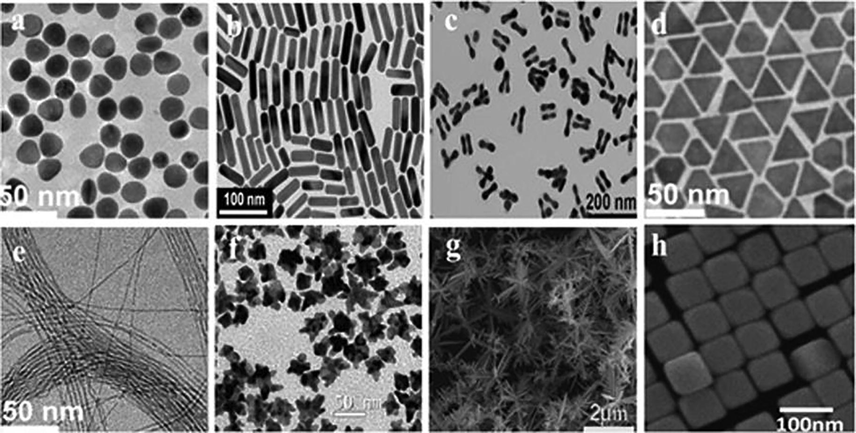
AuNP TEM images: (a) quasi-spheres, (b) nanorods, (c) nanodumbbells, (d) triangular nanoprisms, (e) ultrathin nanowires, (f) nanostars; (g and h) AuNP SEM images: Nanodendrites (g) and (h) nanocubes.
15 Chemicals
Functionalization is disposable in the model of nanoparticles for a specific application and may rely on a surface charge, surfactants, functionality, and stabilizers. The Au0 (non-oxidized state) is the ultimate preferable state for nanoparticles. Thus, the principal stage involving the preparation of positively charged gold nanoparticles AuNPs is to reduce the oxidation of goldAu+1(aureus) or Au+3(auric) to Au0 by adding a reducing agent to the reaction; under intense stirring to form fairly uniform NPs in size. Then the saturation of the AuNPs solution to precipitate moderately. In order to minimize aggregate NPs, a stabilizing medium that adsorbs on the NP surface is typically applied (Daruich De Souza et al., 2019; Teimouri et al., 2018). The principle is the same but there are several methods to achieve.
16 Turkevich-Frens method
This method is used to synthesize AuNPs and was developed in 1951 by J. Turkevich et al. to produce moderately colloidal AuNPs with sizes ranging from 10 to 20 nm. The diameter of the shaped NPs can be changed by varying the amount of reactant used or by using different styles or stabilizing factors. The main disadvantage was that only a limited number of AuNPs could be produced (Teimouri et al., 2018).
17 Brust–Schiffrin method
The Brust–Schiffrin synthesis (BSS) of metal nanoparticles was described in 1994; this method can produce highly stable thiol functionalized nanoparticles (Perala and Kumar, 2013) and can be used to prepare AuNPs in organic solutions (Teimouri et al., 2018). In the end, AuNPs can be isolated as a solid and treated much like, the highly stabilized Brust-Schiffrin analogs (Booth et al., 2017).
18 Martin method
Teimouri and colleagues advanced this method in 2010 by using NaBH4 as a reducing agent for the reduction of HAuCl4. HCl and NaOH are used as “stabilizing agents” in this process, and AuNPs are used as “colloidal dispersion.” The NPS scale is nearly monodispersed, and the diameter can be precisely adjusted from 3 to 5 nm (Teimouri et al., 2018). Microbes can produce biogenic nanoparticles both internally and externally, but extracellular processing is preferable for isolation (Sreedharan et al., 2019). The extraction efficiency of nanoparticles is influenced by the form, amount of extraction of nanoparticles, and concentration (Bosi et al., 2015). The majority of the methods reported for separating and detecting AuNPs required expensive instrumentation, such as field-flow analyzers. In comparison to these costly methods, the optical properties (fluorescence, absorbance, and dispersion) of NPs have been analyzed for AuNP testing utilizing low-cost instruments such as fluorescence and UV spectrometers. However, these approaches have a range of disadvantages, including the usage of organic solvents, lengthy sonication periods at low temperatures, and the need for intermediate evaporation steps. Selective methods for screening metallic NPs are in high demand and of vital importance. The use of eco-friendly sulfonate nano cellulose (s-NC) as a sorbent material is a simple and fast method for detecting gold NPs. The affinity of sulfur atoms to metals is central to the interaction between s-NC and AuNP. Through stabilizing the NP, the usage of cationic surfactant (+) has significantly aided the extraction of AuNPs. Because of its non-toxic properties and excellent qualities, nano cellulose (NC), extracted from plentiful renewable resources, is a good contender (e.g. compatibility, biodegradability, lightness, high porosity, thermal stability and rigidity). Modified nano cellulose is a promising material for gold nanoparticle extraction (Jesús Dueñas-Mas et al., 2018).
19 Application of gold nanoparticles
Gold nanoparticles, for example, may be used in air cleaning, including the removal of odors and harmful carbon monoxide from rooms, emission management, water purification, power cells, and critical medical applications. Because of their small scale, these particles can enter tissues and attack immune cells, like lymphoid tissues, rendering them potentially useful in immunotherapy (Ahmad et al., 2017). Even though a broad number of medicinal nanoparticles are in (pre-clinical) usage for diagnostic and therapeutic applications, their role on the immune system in terms of particle properties are still poorly known (Fytianos et al., 2015). Researchers worked on vital medical technologies (Fernández et al., 2015), which will be addressed later.
20 Anticancer therapy
Cancer becomes greatest critical soundness problems, the most reason of death in the globe (Dykman, 2019). Significant developments in nanomedicine have given rise to cancer detection and treatment. Due to low toxicity of AgNPs compared to other metal nanoparticles, it showed a predominant preference in medical applications, especially due to low toxicity. Gold nanoparticles also shown outstanding diagnostic and therapeutic uses, including biosensors, targeted distribution of anticancer medications, and enzyme-linked immunosorbent assays. Gold nanoparticles (AuNPs) with increased absorption and scattering properties, optical tenability, and specific tumor targeting competence (Anticancer Activity) for cancer care. Through the advent of chemical synthesis technologies, AuNPs of diverse shapes and sizes with desired properties that can obtain multimodal cancer therapy with extended anti-tumor activity can be synthesized. AuNPs are classified into five main types: gold nanorods, gold nanotubes, gold nanospheres, nanostars, and gold nanocages of different sizes for various applications. The example uses nano-shells to combat cancerous tumors. Gold-shells are tiny balls that are coated with a thin film of nanogold. Nano-shells and nanogold are injected inside the body and aggregated into the tumor, then an infrared ray is applied to the tumor region so that these rays move through healthy tissues safely, however heat the nanoscale shells of gold, so that their temperature rises and the tumor is killed without sacrificing healthy cells. Successful treatment, with minimal side effects (Yang et al., 2019; Soliman et al., 2020). The potential role of AuNPs in scientifically validated cancer therapies such as Chemo-Radio-Therapy (CRT), Thermo-Chemo-Therapy (TCT), Thermo-Radio-Therapy (TRT), Thermo-Chemo-Radio-Therapy (TCRT), and Gene Therapy (GT). Each counseling has a specific purpose in the recovery and has a distinct disadvantage or benefit (Deymehkar et al., 2018). AuNPs are used in ultra-sensitive sensors and imaging-based therapeutic methods for the treatment of severe diseases because of their significant optical properties (Fig. 7) (Singh et al., 2018).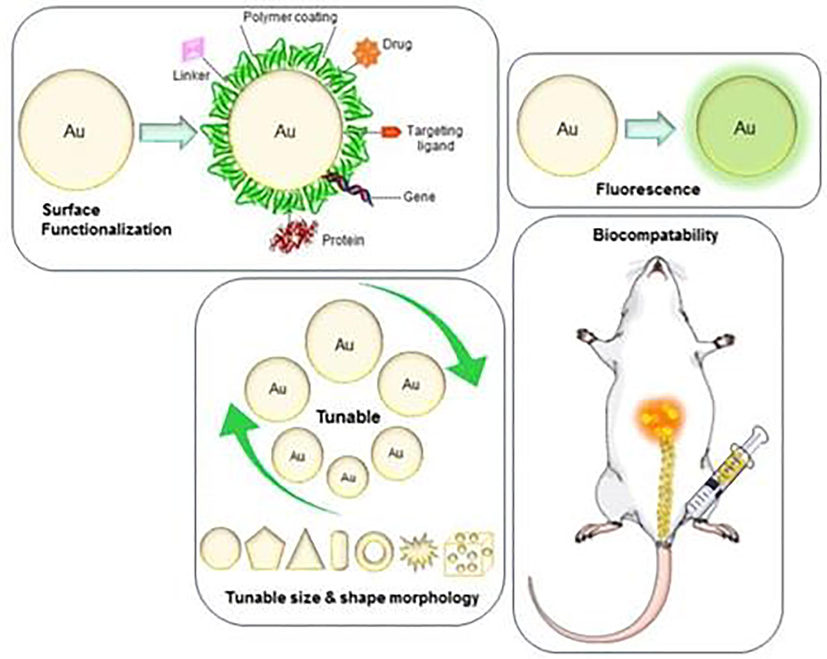
Due to the elevated optical and Surface Plasmon Resonance (SPR) properties of gold nanoparticles, it has become the first option for researchers, especially in the biological and pharmaceutical fields.
21 Drug delivery
Precise delivery of nano-vehicles to diseased tissues, monitoring the rate and area of release of drugs, enhancing drug bioavailability at the goal site, improving drug solubility and stability are few of the attractive features of medication by the use of nanoparticles that reduced mortality. Liposomes, polymers, dendrimers, and metallic nanoparticles have all been used in medicine, but AuNPs have exceptional properties that make them the ideal drug delivery scaffold. AuNPs have easy preparation, are bioinert, and are non-toxic, making them suitable for nano carrier building. The manufacturing tenability of AuNPs allows for the development of particles of varying core diameters and complete power over size dispersion. For example, after chemical therapy, cancer cells become insensible as effect of repeated drug administration, nanoparticles are capable to raise the accumulation of intracellular drugs due to their power to target and distribute more specific drugs. Doxorubicin (DOX)-linked AuNP scans help with medication aggregation and retention in (multi-drug-resistant MCF-7 / ADR cancer). As a consequence, enhanced intracellular DOX concentration results in superior cytotoxicity in cells when opposed to free doxorubicin (Beik et al., 2019).
22 Nano-sensor and biomarker
It is important to calculate the ionizing radiation level of therapeutic radiation, which depends on precise and fast radiation measurements. A new and highly sensitive nano-sensor for Gamma detection is created, with single-stranded DNA fragments serving as “radiation-sensitive data” and gold nanoparticles serving as “signal reporter.” Under optimal conditions, the radiation nano-sensor has outstanding linearity in the 0–100 Gy dose scale. A quick and effective approach that provides a different path for the Gamma-radiation “dosimeter,” which is an instrument used to calculate the absorbed dose of ionizing radiation and could have implications for radiation-induced biological consequences, such as the Chernobyl catastrophe (Wang et al., 2020). MicroRNAs (miRNAs) are small non-coding regulatory RNA molecules that have 19 to 22 nucleotides. It can be used as a biological marker because of its excellent early disease detection features, and it can be detected in a variety of bodily secretions and samples collected. For example, studying the expression of renal microRNAs may help in the early detection of a major cause of kidney failure (diabetic nephropathy) (Khan et al., 2015). There is no role was documented either in obesity (Alshammary and Khan, 2021) or type 2 diabetes-mellitus (Alharbi et al., 2021). However, due to their unique characteristics or low quantities, they are highly challenging to identify. The use of positively charged gold nanoparticles significantly improves the performance of miRNA biosensors (Gauglitz, 2020; Nossier et al., 2020; Hong et al., 2018; Miao et al., 2018).
23 Colorimetric sensing of AuNPs
Colorimetric usage of AuNPs in sensing is one of the most promising analytical approaches for recognizing analytes and detecting biomolecules such as amino acids, peptides and proteins, nucleic acids, inorganic ions, and enzymes. The key mechanism is that while the lengths between the antiparticles are smaller than the average diameter of the AuNPs, the color changes from red to blue, which is readily detectable through the naked eye. The track added to the sensors can be divided into two strategies: red change and blue shift in absorption, which result in AuNP aggregation and disaggregation. The UV–vis spectrophotometer may be used to record the results (Qin et al., 2018).
24 Antimicrobial agents
It is possible that the use of gold nanoparticles as new antibacterial agents may provide a viable alternative to the current methods of limiting or inhibiting the growth of many pathogenic species. The gold nanoparticles synthesized with the help of Solanum nigrum leaf extract were expected to have free radical scavenging action as well as antibacterial static agents, which they achieved. The DPPH radical and hydroxyl radical scavenging abilities of these nanoparticles were demonstrated. These nanoparticles also greatly suppressed the growth of pathogenic Staphylococcus saprophyticus and Bacillus subtilis (Gram-positive bacteria), as well as Escherichia coli and Pseudomonas aeruginosa (gram-negative bacteria) (Muthuvel et al., 2014). An investigation of the antibacterial efficacy of Hibiscus cannabinus stem extract mediated gold nanoparticles against P. aeruginosa and Staphylococcus aureus was undertaken. The antibacterial impact was stronger in the case of P. aeruginosa, which could be owing to electrostatic interaction between positively charged nanoparticles and negatively charged microbe cell surfaces (Bindhu et al., 2014). The antibacterial activity of green synthesised gold nanoparticles derived from the leaf extract of Euphorbia hirta against bacterial strains of Escherchia coli; Pseudomonas aeroginosa, and Klebsiella pneumonia was investigated using the minimal inhibitory concentration (MIC) method, and it was discovered that they were extremely effective against these bacteria (Annamalai et al., 2013).
25 Applications of nanoparticles into plants
AuNPs have been recommended for use in a variety of agricultural crops, as well as in the germination of seeds from endangered plant species (Gopinath and Gowri, 2014; Alabdallah and Hasan, 2021). The effect of AuNPs synthesized utilizing Terminalia arjuna fruit extract on the germination of Gloriosa superba seeds and the growth of the plant's leaves has been investigated. AuNPs were found to have a beneficial effect on seed germination, node elongation, and vegetative growth of plants. Gloriosa superba seed germination and vegetative growth were shown to be strongly correlated with the concentration of AuNPs in the environment. Moreover, it has been observed that spraying AuNPs at concentrations of 10 and 25 mg/L on Brassica juncea plants can increase the quantity of chlorophyll (Arora et al., 2012). Finally, we can conclude that AuNPs have favorable impacts on plant growth and development.
26 Conclusion
Gold nanoparticles consider as a promising future for scientists and researchers, especially in the medical field. Biosynthesis from plants, bacteria, and fungi delivers the desired result with minimal damage compared to other constructing methods. Cancer treatment has found its way with the use of gold nanoparticles.
Declaration of Competing Interest
The authors declare that they have no known competing financial interests or personal relationships that could have appeared to influence the work reported in this paper.
References
- Kalimuthu, K., Cha, B.S., Kim, S., Park, K.S.J.M.J., Eco-friendly synthesis and biomedical applications of gold nanoparticles: a review. 2020;152:104296.
- Inorganic particles for delivering natural products. Sustainable Agric. Rev.. 2020;44:205-241. Springer
- [Google Scholar]
- Ansari, M.J., editor Transport Phenomenon of Nanoparticles in Animals and Humans. Diffusion Foundations; 2019: Trans Tech Publ.
- Gold in a metallic divided state—from faraday to present-day. Nanoscience. 2007;46(29):5480-5486.
- [Google Scholar]
- Nanoparticles in biology and medicine: methods and protocols. Springer; 2012.
- Di Pietro, P., Strano, G., Zuccarello, L., Satriano, C.J., Gold and silver nanoparticles for applications in theranostics. 2016;16(27):3069-102.
- Herizchi, R., Abbasi, E., Milani, M., Akbarzadeh, A., nanomedicine, biotechnology. Current methods for synthesis of gold nanoparticles. 2016;44(2):596-602.
- Cell tracking using gold nanoparticles and computed tomography imaging. Nanobiotechnology. 2018;10(2):e1480.
- [CrossRef] [Google Scholar]
- Dasgupta, N., Ranjan, S.J., Nanotechnology in food sector. 2018:1-18.
- Ingale, A.G., Chaudhari, A.N.J.N., Food Security, Treatment W. Nanotechnology in the Food Industry. 2018:87-128.
- Lee, Y.J., Ahn, E.-Y., Park, Y.J., Shape-dependent cytotoxicity and cellular uptake of gold nanoparticles synthesized using green tea extract. 2019;14(1):1-14.
- Hoshyar, N., Gray, S., Han, H., Bao, G.J.N., The effect of nanoparticle size on in vivo pharmacokinetics and cellular interaction. 2016;11(6):673-92.
- De Souza, C.D., Nogueira, B.R., Rostelato, M.E.C., Compounds. Review of the methodologies used in the synthesis gold nanoparticles by chemical reduction. 2019;798:714-40.
- M. Teimouri, F. Khosravi-Nejad, F. Attar, A.A. Saboury, I. Kostova, G. Benelli, M. Falahati, et al. Gold nanoparticles fabrication by plant extracts: synthesis, characterization, degradation of 4-nitrophenol from industrial wastewater, and insecticidal activity–a review. 2018;184:740-53.
- Qiao, J., Qi, L.J.T., Recent progress in plant-gold nanoparticles fabrication methods and bio-applications. 2020:121396.
- Fu, L.-H., Yang, J., Zhu, J.-.F., Ma, M.-G., Synthesis of gold nanoparticles and their applications in drug delivery. Metal Nanoparticles in Pharma: Springer; 2017. p. 155-91.
- A. Khatua, E. Priyadarshini, P. Rajamani, A. Patel, J. Kumar, A. Naik, et al., Phytosynthesis, characterization and fungicidal potential of emerging gold nanoparticles using Pongamia pinnata leave extract: a novel approach in nanoparticle synthesis. 2020;31(1):125-31.
- Shahriari, M., Hemmati, S., Zangeneh, A., Zangeneh, M.M., Biosynthesis of gold nanoparticles using Allium noeanum Reut. ex Regel leaves aqueous extract; characterization and analysis of their cytotoxicity, antioxidant, and antibacterial properties. 2019;33(11):e5189.
- Yu, T., Xu, C., Qiao, J., Zhang, R., Qi, L.J.C.C.L., Green synthesis of gold nanoclusters using papaya juice for detection of L-lysine. 2019;30(3):660-3.
- Beik, J., Khateri, M., Khosravi, Z., Kamrava, S.K., Kooranifar, S., Ghaznavi, H., et al. Gold nanoparticles in combinatorial cancer therapy strategies. 2019;387:299-324.
- Siddiqi, K.S., Husen AJJoTEiM, Biology. Recent advances in plant-mediated engineered gold nanoparticles and their application in biological system. 2017;40:10-23.
- Bhaskaran, S., Sharma, N., Tiwari, P., Singh, S.R., Sahi, S.V.J., Fabrication of innocuous gold nanoparticles using plant cells in culture. 2019;9(1):1-9.
- Gupta, R., Padmanabhan, P., Biotechnology, Sciences F. Biogenic synthesis and characterization of gold nanoparticles by a novel marine bacteria MARINOBACTER ALGICOLA: progression from nanospheres to various geometrical shapes. 2021;2021:732-7.
- Liu, W, Wang, L., Wang, J., Du, J., Jing, C.J.E.S.N., New insights into microbial-mediated synthesis of Au@ biolayer nanoparticles. 2018;5(7):1757-63.
- Molnár, Z., Bódai, V., Szakacs, G., Erdélyi, B., Fogarassy, Z., Sáfrán, G., et al. Green synthesis of gold nanoparticles by thermophilic filamentous fungi. 2018;8(1):1-12.
- Joshi, C.G., Danagoudar, A., Poyya, J., Kudva, A.K., Dhananjaya, B.J.P.B., Biogenic synthesis of gold nanoparticles by marine endophytic fungus-Cladosporium cladosporioides isolated from seaweed and evaluation of their antioxidant and antimicrobial properties. 2017;63:137-44.
- Sreedharan, S.M., Gupta, S., Saxena, A.K., Singh, R., Macrophomina phaseolina: microbased biorefinery for gold nanoparticle production. 2019;69(4):435-45.
- Osonga, F.J., Akgul, A., Yazgan, I., Akgul, A., Eshun, G.B., Sakhaee, L., et al., Size and shape-dependent antimicrobial activities of silver and gold nanoparticles: a model study as potential fungicides. 2020;25(11):2682.
- Lee, S.H., Jung, H.K., Kim, T.C., Kim, C.H., Shin, C.H., Yoon, T.-S., et al., Facile method for the synthesis of gold nanoparticles using an ion coater. 2018;434:1001-6.
- Elahi, N., Kamali, M., Baghersad, M.H.J.T., Recent biomedical applications of gold nanoparticles: A review. 2018;184:537-56.
- Perala, S.R.K., Kumar, S.J.L., On the mechanism of metal nanoparticle synthesis in the Brust–Schiffrin method. 2013;29(31):9863-73.
- S.G. Booth, A. Uehara, S.-Y. Chang, C. La Fontaine, T. Fujii, Y. Okamoto, et al. The significance of bromide in the Brust–Schiffrin synthesis of thiol protected gold nanoparticles. 2017;8(12):7954-62.
- Bosi, V., Sarti, E., Navacchia, M.L., Perrone, D., Pasti, L., Cavazzini, A., et al., Gold-nanoparticle extraction and reversed-electrode-polarity stacking mode combined to enhance capillary electrophoresis sensitivity for conjugated nucleosides and oligonucleotides containing thioether linkers. 2015;407(18):5405-15.
- Dueñas-Mas, M.J., Soriano, M.L., Ruiz-Palomero, C., Valcárcel, M.J.M.J., Modified nanocellulose as promising material for the extraction of gold nanoparticles. 2018;138:379-83.
- Ahmad, S., Zamry, A.A., Tan, H.-T.T., Wong, K.K., Lim, J., Mohamud, R., Targeting dendritic cells through gold nanoparticles: a review on the cellular uptake and subsequent immunological properties. 2017;91:123-33.
- Fytianos, K., Rodriguez-Lorenzo, L., Clift, M.J., Blank, F., Vanhecke, D., Von Garnier, C., et al. Uptake efficiency of surface modified gold nanoparticles does not correlate with functional changes and cytokine secretion in human dendritic cells in vitro. 2015;11(3):633-44.
- Fernández, T.D., Pearson, J.R., Leal, M.P., Torres, M.J., Blanca, M., Mayorga, C., et al., Intracellular accumulation and immunological properties of fluorescent gold nanoclusters in human dendritic cells. 2015;43:1-12.
- Dykman, L.A., Khlebtsov, N.J.Boe. Gold nanoparticles in chemo-, immuno-, and combined therapy: review. 2019;10(7):3152-82.
- Yang, W., Liang, H., Ma, S., Wang, D., Huang, J.J.S.M., Technologies. Gold nanoparticle based photothermal therapy: Development and application for effective cancer treatment. 2019;22:e00109.
- Soliman, S.S., Alhamidi, T.B., Abdin, S., Almehdi, A.M., Semreen, M.H., Alhumaidi, R.B., et al. Effective targeting of breast cancer cells (MCF7) via novel biogenic synthesis of gold nanoparticles using cancer-derived metabolites. 2020;15(10):e0240156.
- Deymehkar, E., Taher, M.A., Karami, C., Arman, A.J.S., Synthesis of SPR nanosensor using gold nanoparticles and its application to copper (II) determination. 2018;10(4):1329-36.
- Singh, P., Pandit, S., Mokkapati, V., Garg, A., Ravikumar, V., Mijakovic IJIjoms, Gold nanoparticles in diagnostics and therapeutics for human cancer. 2018;19(7):1979.
- Wang, K., Zhang, W., Zhang, X., Hu, X., Chang, S., Zhang, H.J.A.A.M., et al. Highly Sensitive Gold Nanoparticles–DNA Nanosensor for γ-Radiation Detection. 2020;12(37):42403-9.
- Correlation between KCNQ1 and KCNJ11 gene polymorphisms and type 2 and post-transplant diabetes mellitus in the Asian. Indian population.. 2015;2(3):276-282.
- [Google Scholar]
- Screening of Obese Offspring of First-Cousin Consanguineous Subjects for the Angiotensin-Converting Enzyme Gene with a 287-bp Alu Sequence. Journal of Obesity & Metabolic Syndrome.. 2021;30(1):63-71.
- [Google Scholar]
- Alharbi, K.K., Abudawood, M., Khan, I.A., Amino-acid amendment of arginine-325-tryptophan in rs13266634 genetic polymorphism studies of the SLC30A8 gene with type 2 diabetes-mellitus patients featuring a positive family history in the Saudi population. Journal of King Saud University-Science. 2021;33(1):101258.
- Gauglitz, G.J.A., chemistry b. Critical assessment of relevant methods in the field of biosensors with direct optical detection based on fibers and waveguides using plasmonic, resonance, and interference effects. 2020;412(14):3317-49.
- Nossier, A.I., Shehata, N.I., Morsy, S.M., Saeed, D.F., Elsayed, N.M., Ismail, M.F., et al. Determination of certain urinary microRNAs as promising biomarkers in diabetic nephropathy patients using gold nanoparticles. 2020;609:113967.
- Hong, L., Lu, M., Dinel, M.-P., Blain, P., Peng, W., Gu, H., et al. Hybridization conditions of oligonucleotide-capped gold nanoparticles for SPR sensing of microRNA. 2018;109:230-6.
- Miao, X., Cheng, Z., Ma, H., Li, Z., Xue, N., Wang, P.J.A.c., Label-free platform for microRNA detection based on the fluorescence quenching of positively charged gold nanoparticles to silver nanoclusters. 2018;90(2):1098-103.
- Qin, L., Zeng, G., Lai, C., Huang, D., Xu, P., Zhang, C., et al. “Gold rush” in modern science: fabrication strategies and typical advanced applications of gold nanoparticles in sensing. 2018;359:1-31.
- Biosynthesis of gold nanoparticles using Solanum nigrum leaf extract and screening their free radical scavenging and antibacterial properties. Biomed. Prev. Nutr. 2014
- [CrossRef] [Google Scholar]
- Antibacterial activities of Hibiscus cannabinus stem-assisted silver and gold nanoparticles. Mater. Lett.. 2014;131:194-197.
- [Google Scholar]
- Green synthesis, characterization and antimicrobial activity of Au NPs using Euphorbia hirta L. leaf extract. Colloids Surf. B Biointerfaces. 2013;108:60-65.
- [Google Scholar]
- J. Nanostruct. Chem.. 2014;4:115.
- Plant-based green synthesis of silver nanoparticles and its effective role in abiotic stress tolerance in crop plants. Saudi J. Biol. Sci. 2021
- [CrossRef] [Google Scholar]
- Gold nanoparticle induced enhancement in growth and seed yield of Brassica juncea. Plant Growth Regul.. 2012;66(3):303-310.
- [Google Scholar]







